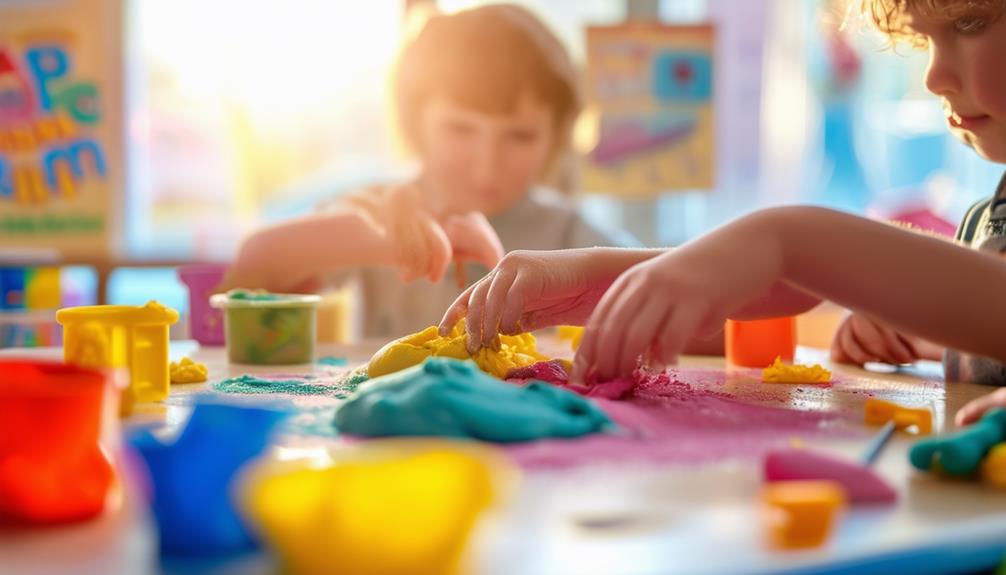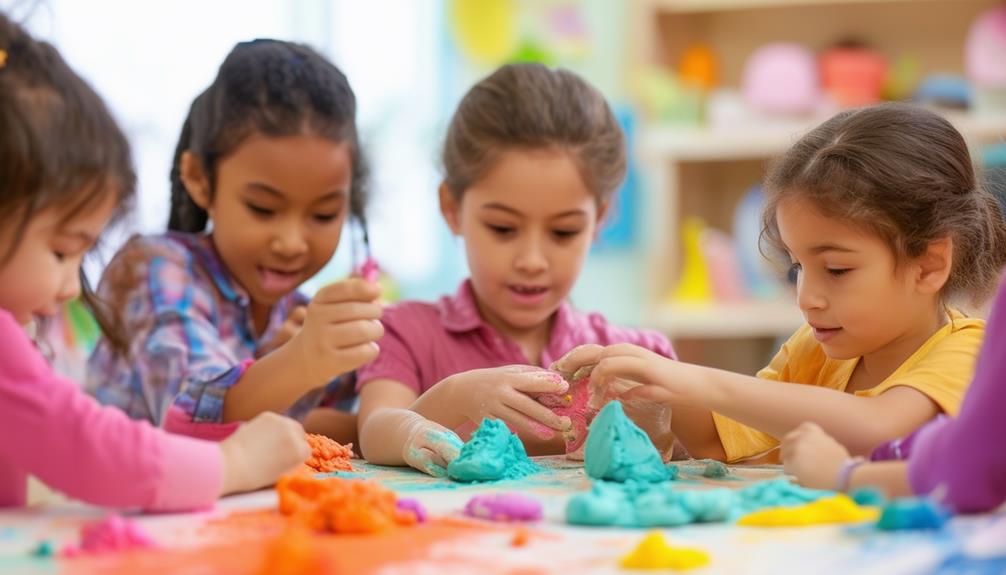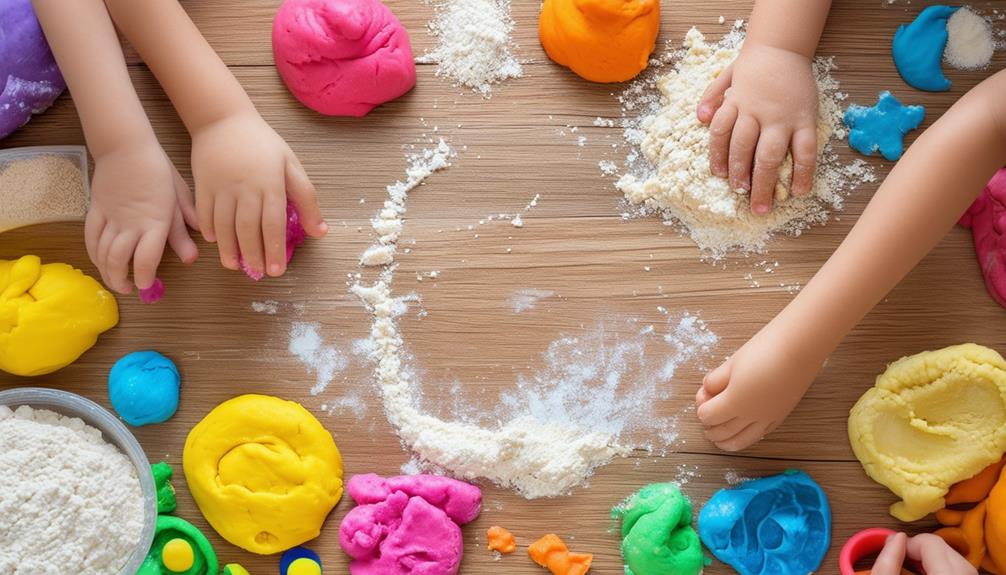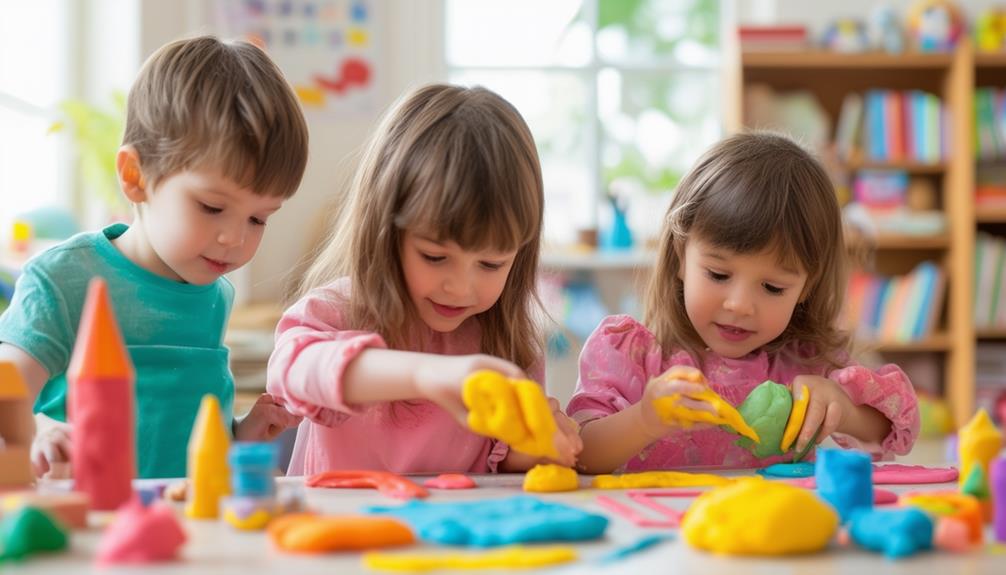Playdough in the Classroom: Educational Uses and Benefits

Incorporating playdough into the classroom goes beyond mere fun for young students. Its benefits are extensive, promoting fine motor skills, enriching sensory experiences, and improving hand-eye coordination. Playdough also facilitates language development through collaborative tasks and verbal communication. Furthermore, this simple tool fosters social and emotional growth. Interested in how playdough can enhance learning environments and support various aspects of child development? Let's explore its multifaceted impact.
Developmental Benefits
Playdough offers significant developmental benefits for children, enhancing fine motor skills, sensory development, and hand-eye coordination. When children mold, pinch, and shape playdough, they strengthen the small muscles in their hands and fingers, essential for tasks like writing and buttoning clothes. The tactile experience of handling playdough also plays a crucial role in sensory development. Kids engage their sense of touch, texture, and sometimes even smell, enriching their sensory awareness.
Playdough is also a fantastic tool for language development. As children describe their creations or follow instructions, they learn new vocabulary and practice verbal communication. This hands-on activity naturally encourages them to express ideas, ask questions, and engage in conversations, enhancing their language skills.
Additionally, playdough supports social and emotional development through collaborative pretend play. When children work together to create with playdough, they learn to share, take turns, and cooperate. This kind of play fosters a sense of competence and achievement, boosting their self-esteem. Furthermore, the imaginative scenarios they create help them understand and express their emotions, laying a foundation for effective communication and emotional intelligence.
Social and Emotional Growth
Engaging with playdough in the classroom fosters children's self-esteem by allowing them to take pride in their creations. As they mold, shape, and design, they experience a sense of accomplishment that enhances their confidence. This hands-on activity also helps children learn to regulate their emotions. Manipulating playdough can serve as an outlet for extra energy and strong feelings, providing a calming effect.
Additionally, playdough activities enhance social skills. When children collaborate on playdough projects, they practice communication and cooperation. They learn to share tools, discuss ideas, and solve problems together, fostering teamwork and collaboration. These interactions are crucial for developing their fine motor and social abilities.
Incorporating playdough into your classroom isn't just about fun and learning; it's about preparing children for success in school and life. The emotional and social skills they develop through these activities are invaluable. By integrating playdough into children's learning, you're supporting a well-rounded educational experience that extends beyond academics. Your students learn to manage emotions, work well with others, and take pride in their work, laying a strong foundation for future growth.
Creativity and Imagination

Incorporating playdough into classroom activities ignites children's creativity and imagination by offering a versatile medium for artistic expression and pretend play. When children engage with playdough, they are not merely having fun—they are participating in valuable learning experiences that foster the development of creative thinking skills. By molding and shaping playdough, children create various objects and scenarios, enhancing their symbolic thinking and imaginative play.
As children mature, their playdough creations become more detailed and complex. This progression underscores the role of playdough in promoting the continuous development of fine motor skills and artistic abilities. Collaborative playdough activities also encourage teamwork with peers and adults, enriching their social skills as they co-create stories and imaginative worlds.
Additionally, playdough's malleability allows children to experiment with different textures, shapes, and colors, further stimulating their creativity. These hands-on experiences teach them to innovate and think outside the box—skills essential for problem-solving and critical thinking. In summary, integrating playdough into classroom learning activities not only provides enjoyment but also supports imaginative and creative growth in meaningful ways.
Language and Literacy
Incorporating playdough into classroom activities not only fosters creativity and imagination but also significantly enhances language and literacy skills. When students create playdough figures or scenes, they are not merely molding shapes but crafting stories and narratives. This hands-on experience builds vocabulary and language skills as students describe their creations and invent stories about them.
Playdough can also be used to teach print and writing concepts in an engaging manner. For example, students can practice forming letters and words with playdough, reinforcing their understanding of the alphabet and spelling. This tactile approach helps solidify literacy concepts in a memorable way.
Additionally, engaging in playdough activities promotes communication and collaboration among students. When children work together on a playdough project, they naturally discuss their actions, share ideas, and negotiate roles. This interaction aids in developing social and language skills, laying a strong foundation for effective communication.
STEM Learning

Incorporating playdough into the classroom can ignite a passion for STEM learning by providing hands-on experiences that make abstract concepts tangible. When children manipulate playdough, they engage in hands-on science, exploring materials, textures, and cause-and-effect relationships. This type of interactive learning is crucial for developing scientific thinking and observation skills.
Playdough activities also enhance mathematical thinking and problem-solving skills. For example, when kids shape playdough into different forms and sizes, they learn about geometry and spatial awareness. Measuring and dividing playdough introduce fundamental concepts of fractions and proportions.
Using playdough to prepare children for future STEM concepts helps foster a love for learning in science, technology, engineering, and math. By making these subjects enjoyable and engaging, you're laying a strong foundation for their academic future.
Here's how playdough can benefit STEM learning:
- Hands-on science: Children experiment with materials, understanding physical properties and cause-and-effect.
- Mathematical thinking: Activities like shaping and measuring enhance understanding of geometry, fractions, and proportions.
- Problem-solving skills: Playdough encourages creativity and critical thinking as children solve challenges in their creations.
Incorporate playdough into your STEM curriculum to create a dynamic and engaging learning environment.




